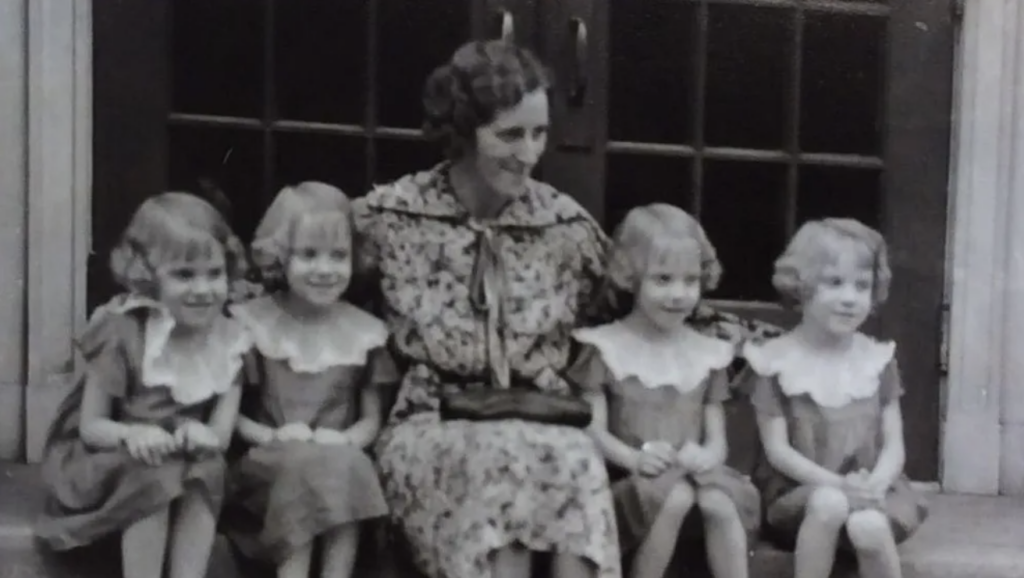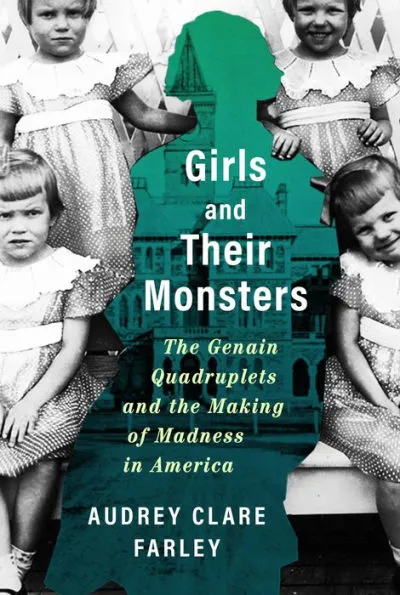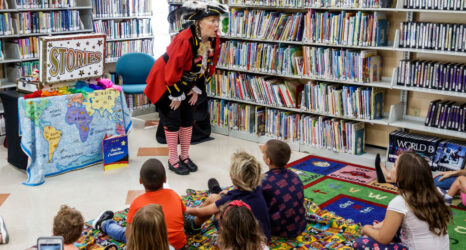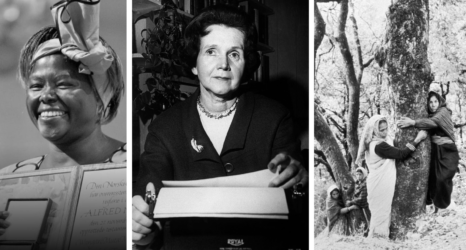Audrey Clare Farley’s book Girls and Their Monsters: The Genain Quadruplets and the Making of Madness in America “is about people living under fascism, but it’s also about bravery and defiance.”

When Edna, Helen, Sarah and Wilma Morlok were born in May 1930, their father, Carl Morlok, was horrified that identical quadruplets had entered the world. After all, he thought multiples to be a sign of low breeding. And he didn’t mince words: After his wife Sadie gave birth, his first words made his position clear: “What will they think my wife is, a bitch dog?”
The family’s story is told in Girls and Their Monsters: The Genain Quadruplets and the Making of Madness in America. The book’s author, Audrey Clare Farley, addresses the sisters’ earliest years as a singing-and-dancing sensation and zeroes in on their coming of age and eventual descent into schizophrenia. Their experience as long-term research subjects at the National Institute of Mental Health—where the surname Genain was used to mask their identities—provides fodder for Farley’s parsing of psychology’s changing views on the root causes of mental illness and gives readers a window into the racial, class and gender prejudices of the experts who studied and treated them. It also spotlights the pathology at play in the Morlok home and the rigid authoritarianism of the family patriarch.
Farley spoke with Ms. reporter Eleanor J. Bader about the book and the politics surrounding mental healthcare in the United States.

Eleanor J. Bader: Both of your books, 2021’s The Unfit Heiress: The Tragic Life and Scandalous Sterilization of Ann Cooper Hewitt and your latest, Girls and Their Monsters, tell stories that take place at the intersection of family dysfunction and medical care.
Do they have anything else in common?
Audrey Clare Farley: Both books are about white women who got caught in the crosshairs of white supremacy.
Ann Cooper Hewitt (1914-1956), the subject of my first book, was a wealthy heiress. People never imagined that such a privileged person could become a victim of forced sterilization. But Ann was perceived to be a threat because she was considered “oversexed.”
In the 1930s, that meant that her mother and others thought her likely to “cross the color line,” or mix with other races.
The racism of 1930s Jim Crow America was also projected onto the quadruplets. Their public performances stoked fantasies about white innocence and dangerous, dark-skinned others. The girls opened for minstrel performers and sang songs glorifying Christopher Columbus. To me, it was obvious that they were being used as puppets to tell a story about America that hid segregation, racism and the genocidal violence at the core of our country’s founding. Predictably, they were beloved by the white audiences they performed for. But that adoration never translated into real regard for their well-being.
Bader: You write that Carl, the girls’ German-born father, was a literal Nazi—yet most of the doctors who treated the quadruplets were Jewish. How did Carl’s fascist beliefs factor into their upbringing and later treatment?
Farley: Carl was an admirer of Hitler. According to Sarah, the sole surviving quadruplet, he wished for Germany to win the war, then for Hitler to come to the United States to purge the country of its own “defective” people. Like many Nazis, he was obsessed with his daughters’ virginity. When the family was studied at NIMH, he accused a Jewish doctor of sleeping with his wife. But when the Jewish psychologist David Rosenthal published a 600-page book on the sisters, The Genain Quadruplets, Carl’s Nazism went unmentioned. I think this had to do with the fact that mid-century psychologists and psychoanalysts thought they had to be politically neutral, and they didn’t view racism as meaningfully shaping psyches. It wasn’t like having bad genes or having been poorly mothered.
Even today, decades after the Morlok family was studied, many psychiatrists and psychologists don’t recognize the ways that racial or religious prejudices shape us—our fears, our desires, our senses of self. And genetic explanations remain very alluring. This doesn’t surprise me. Narratives that reduce schizophrenia to genetics let us off the hook. They absolve us—society—of our responsibility to build a better world.
Like her mother, Sarah perceived it to be a woman’s responsibility to stay married, even at her own expense.
Bader: Carl and Sadie had a volatile marriage but the pair stayed together until Carl’s death. How did Sadie’s ideas about gender and relationships influence her daughters?
Farley: Sadie knew she’d be judged harshly if she left her husband. The family attended a very conservative church, which viewed unyoked women as a great evil. But she was also addicted to the role of stage mother. The notoriety made her feel important, in addition to giving her access to material benefits. The year the quads were born, the city gave them free housing, free milk, even the services of a health department aide. (By contrast, officials were very stingy with needy Black families, including the family of Malcolm X, who grew up a few miles away.)
Sarah is the only one of the four who married. Her husband, George Cotton, was often unkind to her, but she stayed with him for many years. She told me she agreed to marry him because she trusted him not to rape her. The marriage only ended when George was ready to move on, though she was greatly relieved. Like her mother, she perceived it to be a woman’s responsibility to stay married, even at her own expense.
Bader: The Morlok sisters were, of course, individuals, but the media treated them as if they were a single entity. How did this impact their mental health?
Farley: As I write, “They were four, but they were one.”
The media did not care about them as individuals. This became especially blatant when Helen’s mental health began to decline and Sadie pulled her out of high school. When her three sisters graduated, Helen did not join them. There was no acknowledgment of her absence in the local newspaper, which printed a graduation photo of the others. She was not even mentioned.
Bader: Helen and Wilma were circumcised as children because they masturbated. While this behavior was likely their attempt at self-soothing, the medical establishment was more-than-willing to operate on them. Was this common?
Farley: Circumcision was a throwback to eugenics, the movement to stop “unfit” people from reproducing. The thinking was that a person who masturbated was likely to race-mix and dilute the white race. Experts saw surgery as a way to stop these wayward impulses. I want to stress that the doctor who performed the surgery was not an outlier in 1940s America.
Bader: One of the reasons Carl gave for keeping his daughters on a tight leash and not allowing them to socialize as children and teenagers was that he was fearful that they’d be kidnapped. Was this an actual threat?
Farley: The kidnapping of children like Charles Augustus Lindbergh, Jr., the 20-month-old son of Charles Lindbergh and Anne Morrow Lindbergh, in 1932, was of concern to people who were in the public eye. Kidnapping was directed at wealthy people who could pay a hefty ransom. Perhaps, being prominent, the Morloks might have been targeted, but I did not get the impression that kids from working-class families like theirs were in any real danger. Carl simply used the idea of abduction to restrict the girls’ activities.
Bader: The Morlok act included singing and dancing. Did they know or ever perform with Shirley Temple, another well-loved child performer?
Farley: They never met Shirley Temple, but they were enamored with her and created a scrapbook of photos and articles about her. Sometimes Sadie would give the girls money so they could watch a Shirley Temple matinee before their father returned from work. They loved seeing her on screen.
And they had a lot in common. Like the Morloks, Temple was portrayed as having a charmed life, but behind the scenes she was abused. The public did not learn this until much later. The Morloks also presented as smiling and happy children when they were being controlled, manipulated and abused by their dad. Since their mom did nothing to stop him, she was complicit.
Like the Morloks, [Shirley] Temple was portrayed as having a charmed life, but behind the scenes she was abused. The public did not learn this until much later.
Bader: Public school teachers, counselors, social workers and school nurses now have a legal obligation to report suspected abuse and neglect to child welfare authorities. These mandates did not exist when the Morloks were growing up. Do you think they would have made a difference?
Farley: These requirements help kids who attend public schools, but I suspect that if the Morloks were coming of age today, they would be homeschooled. In homeschool communities, abuse is rampant. This has a lot to do with the influence of figures like James Dobson, founder of Focus on the Family. Dobson came to prominence just as stories about child abuse in the home were beginning to be taken seriously by society. As soon as feminists forced a conversation about what was going on behind closed doors, he came along to promote ideas about parents’ rights and the necessity of rigid child discipline.
Religious conservatives pretend that it is only their enemies who abuse children. This moral panic is centuries-old. Think of how European Christians accused Jews of preying upon Christian children and using their blood in a ritual reenactment of the crucifixion. This conspiracy helped fuel pogroms and the Holocaust, and it is at the heart of QAnon and the trans “groomer” panic. So even though we have mandatory reporting laws, mythology endures—and the mythology prevents people from seeing abuse as something that happens all the time at the hands of fathers, brothers, pastors and other familiar people.
Bader: During the Morlocks time at NIMH, some of the psychologists blamed Mom for every bad thing that happened. The book traces the evolution of thinking about mental illness to the present moment, where experts now assume mental illness to be the result of environmental, genetic or psychosocial factors, or some combination of them.
Farley: In the 1940s, Frieda Fromm-Reichmann introduced the “schizophrenogenic” mother theory, which argued that mothers drove their children crazy. She actually didn’t intend to singularly blame mothers, but this theory became her legacy. It really influenced many of the experts at NIMH. Even though those who studied the quadruplets were presented with Carl, one of the worst fathers on earth—an actual Nazi who abused his kids—they still blamed Sadie. Even more ridiculous, they blamed Carl’s problems on his mother!
Bader: You write about the Little family, the low-income African Americans who lived in Lansing at the same time as the Morloks. Did they know each other?
Farley: No. But they could have been cast in the same play as foils for each other. The quadruplets were infantilized throughout their childhood and teen years, while the Little children were “adultified”—treated like adults even though they were children. The quadruplets’ home was under-surveilled, and the Littles’ home was over-surveilled. In both cases, the children suffered.
Bader: What do you want readers to take away from Girls and Their Monsters?
Farley: I want to stress that I don’t view the quadruplets only as victims. They looked for and found joy. The book is about people living under fascism, but it’s also about bravery and defiance. Sarah urged me to use their real names rather than the pseudonyms used in Rosenthal’s book. I hope readers will recognize the courage that took.
Up next:
U.S. democracy is at a dangerous inflection point—from the demise of abortion rights, to a lack of pay equity and parental leave, to skyrocketing maternal mortality, and attacks on trans health. Left unchecked, these crises will lead to wider gaps in political participation and representation. For 50 years, Ms. has been forging feminist journalism—reporting, rebelling and truth-telling from the front-lines, championing the Equal Rights Amendment, and centering the stories of those most impacted. With all that’s at stake for equality, we are redoubling our commitment for the next 50 years. In turn, we need your help, Support Ms. today with a donation—any amount that is meaningful to you. For as little as $5 each month, you’ll receive the print magazine along with our e-newsletters, action alerts, and invitations to Ms. Studios events and podcasts. We are grateful for your loyalty and ferocity.





